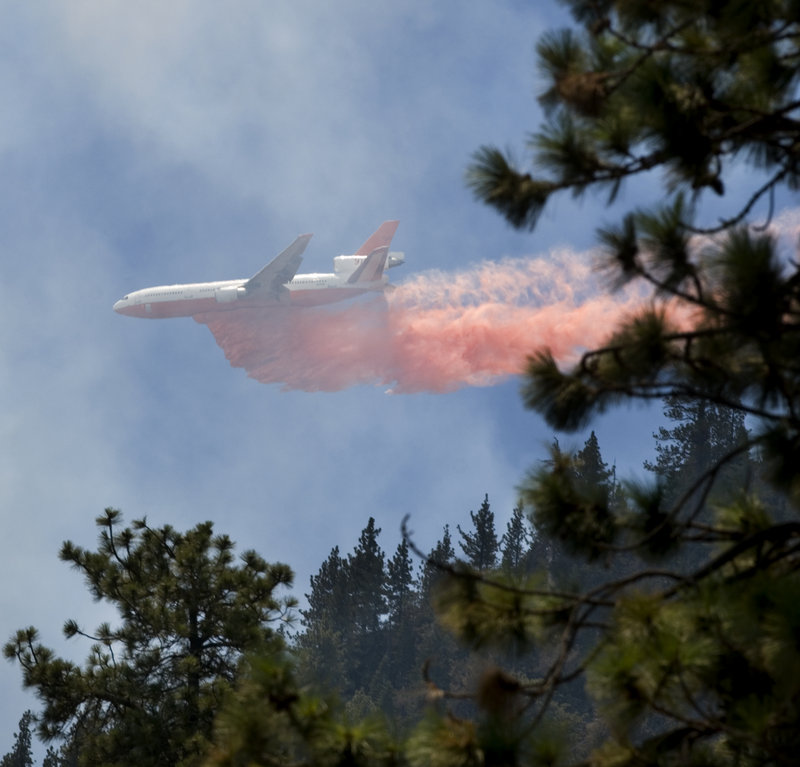BANNING, Calif. – California truly is the Golden State this summer — golden brown — and that has fire officials worried heading into the peak of the wildfire season.
It’s still weeks before the fire-fanning Santa Ana winds usually arrive and already it’s been a brutal fire season, with nearly twice as many acres burned statewide from a year ago, including 19,000 scorched this week in a blaze still raging in the mountains 90 miles east of Los Angeles. That fire, burning nearly 30 square miles, was almost half contained Saturday morning.
So far this year, California fire officials have battled 4,300 wildfires, a stark increase from the yearly average of nearly 3,000 they faced from 2008 to 2012, said Daniel Berlant, a spokesman for the California Department of Forestry and Fire Protection.
Until last week, those fires had already burned more than 71,000 acres, about 111 square miles. The totals were up from 40,000, about 63 square miles, during the same period last year.
The annual average for charred land in the last five years was 113,000 acres, roughly 177 square miles, he said.
“We have seen a significant increase in our fire activity and much earlier than normal,” said Berlant, adding that fire season began in mid-April, about a month ahead of schedule after an especially dry winter. “We’re not even yet into the time period where we see the largest number of damaging fires.”
U.S. Sen. Barbara Boxer, D-Calif., who lives in Riverside County, said more than 165,000 acres or 258 square miles have burned in California this year, and climate change is setting conditions for more disastrous blazes, while budget cuts are limiting resources to fight them. Boxer’s data comes from both California officials and federal agencies, including the U.S. Forest Service.
This year, state fire officials have called up more firefighters and reserve engines on days with hot, dry conditions, Berlant said.
And while state officials encouraged residents to rid their properties of dry brush before fire season starts, he said authorities are now urging the public not to use lawn mowers or weed eaters during the heat of the day because a spark off the metal blades can trigger a blaze.
On Friday, firefighters launched a fleet of seven retardant-dropping airplanes against Southern California’s latest destructive wildfire, which has destroyed 26 homes and threatened more than 500 others in the San Jacinto Mountains.
The so-called Silver Fire injured six firefighters and seriously burned one civilian and had grown to nearly 30 square miles early Saturday.
At its peak, it forced the evacuation of 1,800 people, including 800 campers, but orders were lifted for many areas Friday and only a few hundred evacuees remained.
Gov. Jerry Brown declared an emergency for the area Friday, freeing up additional funds and resources for the firefight and recovery.
In the Twin Pines neighborhood outside Banning, Andy Schrader, 74, said he couldn’t get out in time. The wildfire crept up suddenly and blew over his house, burning his motor home and singeing his hair as he sprayed water from a hose to try to keep the house wet.
“I could feel my face burning,” the carpenter said. “And I thought I was going to die.”
Most of Southern California’s severe wildfires are associated with Santa Ana winds, caused by high pressure over the West that sends a clockwise flow of air rushing down into the region.
This week’s fire, however, was being fanned by a counter-clockwise flow around a low pressure area over northwest
Experts say the fire season has grown longer as rainfall has been lower than usual and tapered off sooner.
Send questions/comments to the editors.



Success. Please wait for the page to reload. If the page does not reload within 5 seconds, please refresh the page.
Enter your email and password to access comments.
Hi, to comment on stories you must . This profile is in addition to your subscription and website login.
Already have a commenting profile? .
Invalid username/password.
Please check your email to confirm and complete your registration.
Only subscribers are eligible to post comments. Please subscribe or login first for digital access. Here’s why.
Use the form below to reset your password. When you've submitted your account email, we will send an email with a reset code.